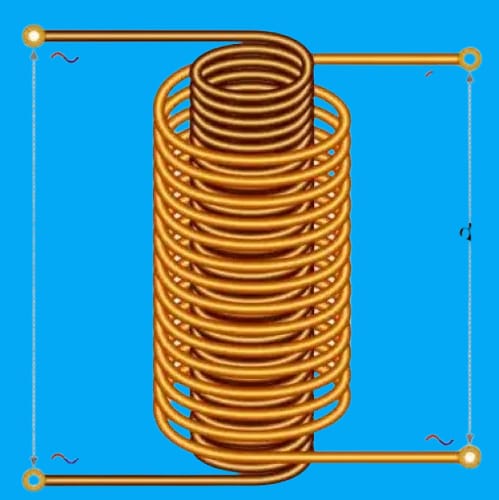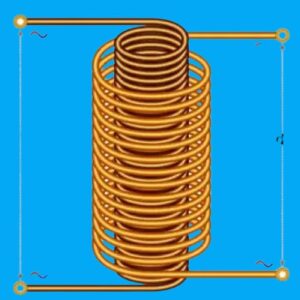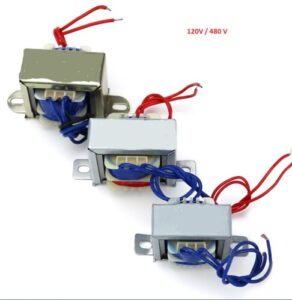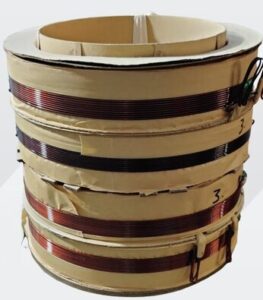
1- Air Core Transformers: A Comprehensive Guide
Transformers are an important part of electrical equipment that transmits energy from one circuit to another. They are ubiquitous in power transmission systems, electrical equipment, and electronic devices. Air core transformers, also known as air transformers, are a particular type of transformer that has several unique features and advantages. In this comprehensive guide, we will explore the basics of air-core transformers, including their working principles, types, applications, advantages, disadvantages, and limitations.
2- Introduction to Electrical core Transformers
A transformer is a component of electrical equipment that uses electromagnetic induction to move electrical energy from one circuit to another. The main primary and secondary windings are two or more wire copper coils that are twisted around a single magnetic silicon core. Transformers are employed in AC circuits to step up or step down the voltage, current, or power. They are widely utilized in electrical equipment, electronic gadgets, and power transmission and distribution networks.
3- What are an Air Core Transformers?
A transformer with an air core uses air as the core material rather than a ferromagnetic material like iron or steel. A non-magnetic former, which can be constructed of plastic, ceramic, or glass, is used to wind the main and secondary windings. Transformers with an air core have a number of benefits over those with an iron core, including fewer losses, a wider bandwidth, and less saturation. The magnetic characteristics of iron cores may limit their performance in high-frequency and high-voltage applications, where they are often used.
4- Working Principle of a an Air Core Transformers
An air core transformer’s functioning is determined by the principles of electromagnetic induction. When an alternating current flows through the primary winding, it creates an alternating magnetic field that changes direction and strength. By mutual induction, this magnetic field makes the secondary winding produce a voltage that is equal to the ratio of the number of turns in the primary and secondary windings. The voltage induced in the secondary winding is an exact copy of the voltage in the main winding, except for the number of turns.
4.1 Construction of Air Core Transformers
Air core transformers are constructed by winding coils of insulated copper wire around non-metallic structures like plastic tubes or cardboard. These transformers primarily come in two forms: cylindrical and toroidal.
In the cylindrical form, the insulated copper wires are wound around a hollow, non-metallic cylinder, which provides essential mechanical support. The copper windings are tapped at various points to facilitate the extraction of the secondary supply. To maintain constant resonance in tuning circuits, capacitors are sometimes connected to the windings. The magnetic flux flows through the air surrounding the windings and inside the hollow cylinder.
For proper impedance matching, a guard winding is often added around the main copper winding. This guard winding is then connected to antenna receivers or grounded appropriately to enhance performance and reduce interference.
4.1 Assembly of Air Core Transformer
The helically wound, insulated strands of copper, are encowled upon a synthetic conduit or cardboard, among others. Primarily, there are two configurations of air-core transformers. One manifests as a cylindrical entity, while the other adopts a toroidal manifestation. Within the cylindrical rendition of the air transformer, insulated copper filaments wrap around a non-metallic cylindrical scaffold. This hollow, non-metallic structure provides the winding with the requisite structural reinforcement.
The copper spiral encircling the non-metal cylinder is punctuated at discrete junctures as deemed necessary. The secondary power supply derives from these junctures. Occasionally, a capacitor integrates with the winding to uphold the perpetual resonance of the tuning circuit. The magnetic flux traverses the air encompassing the winding as well as the air within the hollow cylinder. To achieve proper impedance alignment, a protective winding may be used to encase the primary copper winding. This protective winding is subsequently linked to antenna receptors or duly grounded.
Conversely, in the toroidal manifestation of the air core transformer, insulated copper strands wrap around a rigid plastic ring or alternative non-metallic material. Indeed, the wire is wound in a circular manner around the periphery of the ring. Such transformers find exclusive application in exceedingly high-frequency scenarios. In such instances, the winding lacks any tapping; instead, distinct windings cater to primary and secondary functions. Consequently, the influence of incidental coupling is curtailed within the toroidal air core transformer. The ratio between primary and secondary windings fluctuates, contingent upon the frequency spectrum and operational modality.
5- Types of Air Core Transformers
There are three main types of air core transformers, depending on the shape and arrangement of the winding:
5.1 Single-Layer Air Core Transformers
A single winding is wrapped around a bobbin, which is a non-magnetic form, to create a single-layer air core transformer. The needed voltage ratio determines the number of turns in the winding, which normally consists of a single layer of wire.
Single-layer air core transformers provide a variety of benefits over iron-core transformers due to the absence of a magnetic core. Their large bandwidth is one of their key benefits, which makes them perfect for applications that call for a quick reaction and less distortion. The danger of magnetic interference with neighboring components or systems is also eliminated by the lack of a magnetic core.

Medical equipment, audio amplification, and radio transmission all often employ single-layer air core transformers. They are used in audio amplification to match the output stage’s impedance to the load, whereas they are employed in radio communication to couple signals between stages. They are used in imaging and sensing applications in medical equipment.
Single-layer air core transformers do have certain restrictions, though. They are less appropriate for applications requiring strong mechanical resilience since they have a lower power handling capability than iron core transformers and are more sensitive to mechanical stress.
In conclusion, single-layer air core transformers are perfect for some applications because they have a high bandwidth, less distortion, and no magnetic interference. The applicability of these devices for various applications may be constrained by their reduced power handling capability and susceptibility to mechanical stress. The unique needs of the application and the trade-offs between their relative benefits and limits determine whether single-layer air core or iron core transformers should be used.
5.2- Multi-Layer Air Core Transformer
An air core transformer, known as a multi-layer air core transformer, has several windings encircling a bobbin or non-magnetic form. The needed voltage ratio determines the number of turns in each layer of the windings, which are normally constructed of multiple layers of wire.
Multi-layer air core transformers have a number of advantages over iron core transformers due to the absence of a magnetic core. Its great efficiency, which results from the absence of core losses from hysteresis or eddy currents, is one of their key advantages. Its low sensitivity to temperature fluctuations, which guarantees steady operation across a wide range of temperatures, is another benefit.
In aerospace and defense applications, where high performance and durability are crucial, multi-layer air core transformers are frequently employed. Their high efficiency and low distortion make them perfect for imaging and sensing applications in medical equipment, where they are widely employed.
Multi-layer air core transformers do have certain restrictions, though. In addition to having a lesser power handling capability than iron core transformers, they may not be suitable for applications that call for low leakage inductance due to their high leakage inductance. In order to assure dependable functioning, their susceptibility to mechanical stress may necessitate extra mechanical support.
In conclusion, multi-layer air core transformers are perfect for several high-performance applications because to their high efficiency, low sensitivity to temperature fluctuations, and minimal distortion. The applicability of these devices for various applications may be constrained by their reduced power handling capability and susceptibility to mechanical stress. The precise needs of the application and the trade-offs between their relative benefits and limits determine whether multi-layer air core or iron core transformers should be used.
5.3- Toroidal Air Core Transformers
Transformers known as toroidal air core transformers use a toroidal-shaped coil rather than a conventional rectangular or cylindrical coil. A non-magnetic toroidal core is wrapped around the toroidal coil to create a small, effective design.
The great efficiency of toroidal air core transformers is one of its key benefits. Because of the coil’s toroidal form, less wire is required, which lowers coil resistance and losses. The toroidal core’s design also lessens magnetic flux leakage, strengthening coupling between the primary (HV) and secondary (LV) windings and boosting efficiency even further.
The minimal electromagnetic interference of toroidal air core transformers is another benefit (EMI). By limiting the amount of magnetic flux that leaves the transformer, the toroidal core lowers the risk of EMI.
In music equipment and power supplies, where high efficiency and low EMI are crucial, toroidal air core transformers are frequently used. Their small size and great efficiency make them perfect for use in inverters and battery chargers in renewable energy systems like solar and wind power systems.
Toroidal air core transformers do, however, have significant drawbacks. It may be more challenging to wind the coil because of the toroidal form of the core, which calls for particular tools and methods. Also, the transformer’s toroidal structure can make it challenging to later add more windings or change the turn ratio.
In conclusion, toroidal air core transformers are appropriate for several applications, including audio equipment, power supplies, and renewable energy systems, due to their high efficiency, low EMI, and small design. Nevertheless, because of their toroidal structure, they may be more difficult to wind and have less flexibility when it comes to changing the turn ratio or adding more windings. The precise needs of the application and the trade-offs between their relative benefits and drawbacks determine whether toroidal air core transformers or other types of transformers should be used.
6- Advantages of Air Core Transformers
Air core transformers have several advantages over iron core transformers, including:
- Lower losses: Air core transformers have lower core losses than iron core transformers because they do not have hysteresis and eddy current losses.
- Higher bandwidth: Air core transformers have a higher bandwidth than iron core transformers because they do not exhibit magnetic saturation at high frequencies.
- Less distortion: Air core transformers produce less distortion than iron core transformers because they do not have nonlinear magnetic characteristics.
- No magnetic interference: Air core transformers do not produce magnetic interference or coupling with other nearby components or circuits.
- Lower weight: Air core transformers are lighter than iron core transformers because they do not have heavy magnetic cores.
- Higher efficiency: Air core transformers have higher efficiency than iron core transformers because they do not have core losses and are less susceptible to temperature changes.
These advantages make air core transformers a preferred choice for applications where high-frequency response, low distortion, and low weight are critical, such as radio communication, audio amplification, medical equipment, and aerospace.
7- Limitations of Air Core Transformers
Despite their advantages, air core transformers also have some limitations, including:
- Lower power handling capacity: Air core transformers have lower power handling capacity than iron core transformers because they do not have high magnetic flux densities.
- Higher leakage inductance: Air core transformers have higher leakage inductance than iron core transformers because they do not have a magnetic core to confine the magnetic field.
- Higher sensitivity to mechanical shock: Air core transformers are more sensitive to mechanical shock than iron core transformers because they do not have a rigid magnetic core to support the windings.
These limitations make air core transformers less suitable for applications where high power, low leakage inductance, and high mechanical robustness are required, such as power supplies, motor drives, and transformers for grid-connected systems.
8- Applications of Air Core Transformers
In many different applications where high-frequency responsiveness, low distortion, and light weight are essential, air core transformers are employed. The following are some typical uses for air core transformers:

- Radio communication: Air core transformers are used in radio frequency (RF) circuits to match the impedance of the antenna to the transmitter or receiver.
- Audio amplification: Air core transformers are used in audio amplifiers to couple the signal from the output stage to the speaker or headphones.
- Medical equipment: Air core transformers are used in medical equipment, such as magnetic resonance imaging (MRI) systems and ultrasonic imaging systems, to generate and detect high-frequency signals.
- Aerospace: Air core transformers are used in avionics and aerospace systems, such as satellite communication and navigation systems, to convert and filter high-frequency signals.
8- Air Core Transformer vs. Iron Core Transformers
The most prevalent type of transformer used in electrical apparatus and power systems is one with an iron core. To contain the magnetic field and raise the magnetic flux density, they employ a ferromagnetic core material, such as iron or steel. To cause the voltage in the secondary winding, the primary and secondary windings are coiled on the core.
On the other side, air core transformers employ air as the core material rather than a ferromagnetic substance. They perform better than iron core transformers in terms of bandwidth, losses, and saturation, but they are less powerful, have higher leakage inductance, and are more sensitive to mechanical shock.
9- Comparison between Air Core Transformer and Iron Core Transformers
The following table summarizes the main differences between air core and iron core transformers:
| Parameter | Air Core Transformer | Iron Core Transformer |
| Core material | Air | Ferromagnetic material |
| Power handling | Low | High |
| Leakage inductance | High | Low |
| Frequency range | High | Low |
| Magnetic coupling | Low | High |
| Efficiency | High | Low |
| Size and weight | low | High |
Since air core transformers don’t contain a heavy core material, they are typically smaller and lighter than iron core transformers.
10- Design Considerations for Air Core Transformers
Designing an air core transformer requires careful consideration of several factors to ensure optimal performance and efficiency. Here are some of the key design considerations for air core transformers:
10.1 Voltage and Current Ratings
- The voltage and current ratings are critical parameters for any transformer, as they determine the size and number of turns of the winding. The voltage rating should be selected to ensure that the transformer can handle the maximum expected voltage without breakdown. Similarly, the current rating should be selected to ensure that the transformer can handle the maximum expected current without overheating.
10.2 Core Size and Shape
- The size and shape of the core are critical factors in determining the performance of the transformer. For air core transformers, the shape of the core can vary from cylindrical to toroidal, with the latter being more common due to its superior magnetic properties. The size of the core should be selected to ensure that the windings can be placed in close proximity to minimize the leakage inductance.
10.3 Winding Configuration
- The winding configuration of an air core transformer can have a significant impact on its performance. In general, a multi-layer winding configuration is preferred for high-frequency applications, as it reduces the skin and proximity effects. Additionally, careful consideration should be given to the direction of winding and the orientation of the windings relative to each other to minimize parasitic capacitance and inductance.

10.4 Wire Size and Insulation
- The size of the wire and its insulation play key roles in determining the transformer’s current carrying capacity and voltage rating. Larger wire sizes are typically preferred for higher current carrying capacities, but this could also result in an increase in parasitic capacitance and inductance. In a similar manner, the insulation should be chosen to guarantee that it can withstand the highest anticipated voltage without breaking down.
10.5 Parasitic Effects
- Capacitance, inductance, and resistance are parasitic effects that can have a big impact on how well an air core transformer works. The positioning and orientation of the windings, the size and shape of the core, and the insulation used all need to be carefully taken into account in the design in order to reduce these effects.
Last but not least, when designing an air core transformer, it is important to carefully take into account a number of variables, such as voltage and current ratings, core size and shape, winding configuration, wire size and insulation, and parasitic effects. An air core transformer with high efficiency and the best performance for the particular application can be designed by maximizing these parameters.
11- Testing and Maintenance of Air Core Transformers
To make sure they are working at their best efficiency and to avoid failures that could result in equipment damage or downtime, air core transformers need to be tested and maintained on a regular basis. The following are a few crucial factors to take into account when inspecting and maintaining air core transformers.
- Visual Inspection: By performing routine visual inspections of the transformer, you can find any signs of damage, like cracks or deformations, that might have an impact on how well it performs.
- Electrical Testing: The transformer must pass an electrical test that involves measuring its resistance, inductance, and capacitance to make sure they fall within the allowed ranges. Testing for voltage and current distribution also helps ensure that the transformer is operating efficiently.
- Frequency response analysis can help identify any variations in the transformer’s frequency response, which may indicate problems like distorted windings, deteriorated insulation, or loose connections.
- Degaussing: Degaussing is the removal of any leftover magnetism that might build up in the transformer and cause distortions in the output signal.
- Maintenance: Cleaning the windings and removing any dust or debris that could impair the performance of air core transformers are part of routine maintenance. Other crucial maintenance tasks include tightening loose connections and lubricating moving parts.
- Repairs: To prevent further damage and to guarantee that the transformer continues to function at its highest efficiency, any damage or defects discovered during testing or maintenance should be repaired right away.
- Record-keeping: By keeping track of all testing and maintenance activities, it is possible to spot patterns or recurrent issues and take preventative action to stop failures in the future.
In summary, testing and maintenance are crucial for ensuring the durability and dependability of air core transformers. The effective operation of air core transformers is dependent on a number of factors, including routine inspections, electrical testing, frequency response analysis, degaussing, maintenance, repairs, and record-keeping.
12- Safety Precautions for Air Core Transformers
There are still vital safety precautions that should be taken when working with air core transformers, even though they do not present the same safety risks associated with high voltages as iron core transformers do. Here are some important safety considerations:
- Before performing any work on the transformer, always turn off the power source. This will shield people from unintentional electric shocks.
- When working with air core transformers, put on the proper personal protective equipment (PPE), such as insulated gloves and safety goggles.
- Avoid touching any exposed conductors or connections while the transformer is energized.
- Do not overload the transformer beyond its rated capacity. This can cause overheating and damage to the windings.
- Use caution when handling the transformer, as it may be fragile and prone to damage.
- Always follow manufacturer guidelines and recommended operating conditions for the transformer.
- Ensure that the transformer is properly grounded to prevent electrical shock.
- Regularly inspect and maintain the transformer to ensure proper operation and prevent any potential safety hazards.
By following these safety precautions, you can help ensure the safe and reliable operation of air core transformers in your applications. Always prioritize safety when working with electrical equipment.
13- Conclusion
Compared to iron core transformers, air core transformers provide a number of benefits, such as greater bandwidth, less distortion, no interfering interference (AE), a lighter weight, and higher efficiency. They are frequently employed in applications including radio communication, audio amplification, medical equipment, and aircraft where high-frequency responsiveness, low distortion, and light weight are essential.
Air core transformers are less appropriate for applications requiring high power, low leakage inductance, and high mechanical resilience due to their limitations in terms of their lower power handling capability, higher leakage inductance, and higher susceptibility to mechanical shock.
In conclusion, the decision between air core and iron core transformers is based on the needs of the individual applications and the trade-offs between their individual benefits and drawbacks.
14- FAQs
Can air core transformers handle high power applications?
Air core transformers have a lower power handling capacity than iron core transformers and may not be suitable for high power applications.
Are air core transformers more efficient than iron core transformers?
Yes, air core transformers are more efficient than iron core transformers due to their absence of core losses and lower susceptibility to temperature changes.
What are the main advantages of air core transformers?
The main advantages of air core transformers include higher bandwidth, less distortion, no magnetic interference, lower weight, and higher efficiency.
What are the main limitations of air core transformers?
The main limitations of air core transformers include lower power handling capacity, higher leakage inductance, and higher sensitivity to mechanical shock.
What are some common applications of air core transformers?
Air core transformers are commonly used in radio communication, audio amplification, medical equipment, and aerospace applications.

Leave a Reply